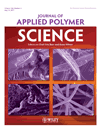Flow behavior in a corotating twin-screw extruder of pure polymers and blends: Characterization by fluorescence monitoring technique
Abstract
The objective of this work was to investigate the flow behavior of pure polymers and blends, especially miscible polymer/polymer systems, in a corotating twin-screw extruder (TSE) using an online fluorescence monitoring device. An immiscible blend was also studied for the sake of comparison. The fluorescence signal was obtained by using synthesized fluorescence tracers added to the melt at very low concentrations. These tracers consisted of two styrene-maleic anhydride copolymers (SMA) labeled with anthracene. The investigated blends were SMA8 (8 wt % of MA in SMA)/polystyrene (PS), SMA14 (14 wt % of MA in SMA)/styrene acrylonitrile copolymer (SAN), and poly(methyl methacrylate) (PMMA)/ethyl acrylate-methyl methacrylate copolymer (PMMAEA). The residence time distribution (RTD), the mean residence time (t), the dimensionless variance (σθ2), the Peclet number (Pe) and the fluorescence peak intensity distribution of pure polymers and binary polymer systems were investigated and interpreted in terms of polymers rheological properties. It was observed that polymers presenting higher viscosity or higher pressure showed longer residence time. A difference in behavior was also observed for the RTD of miscible and immiscible blends. © 2010 Wiley Periodicals, Inc. J Appl Polym Sci, 2011




